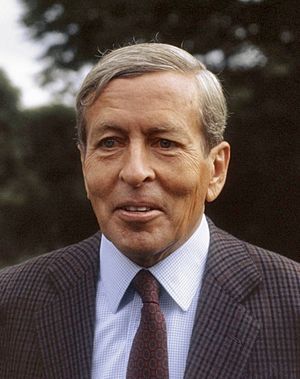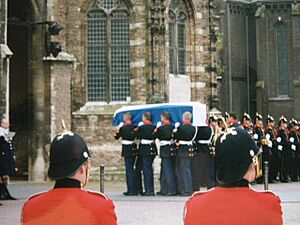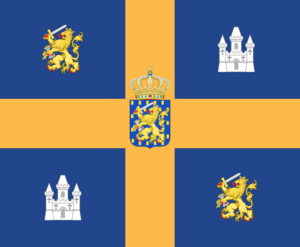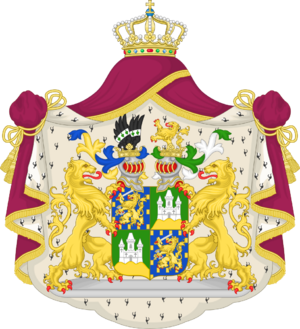Prince Claus of the Netherlands facts for kids
Quick facts for kids Claus von Amsberg |
|
|---|---|

Prince Claus in 1986
|
|
| Prince consort of the Netherlands | |
| Tenure | 30 April 1980 – 6 October 2002 |
| Born | Klaus-Georg Wilhelm Otto Friedrich Gerd von Amsberg 6 September 1926 Hitzacker, Germany |
| Died | 6 October 2002 (aged 76) Bijlmermeer, Netherlands |
| Burial | 15 October 2002 Nieuwe Kerk, Delft, Netherlands |
| Spouse | |
| Issue | Willem-Alexander of the Netherlands Prince Friso Prince Constantijn |
| House | Amsberg |
| Father | Claus Felix von Amsberg |
| Mother | Baroness Gösta von dem Bussche-Haddenhausen |
| Religion | Lutheranism (until 1966) Reformed (from 1966) |
| Occupation | |
| Signature |  |
Prince Claus of the Netherlands (born Klaus-Georg Wilhelm Otto Friedrich Gerd von Amsberg; 6 September 1926 – 6 October 2002) was the Prince consort of the Netherlands. He held this role from 30 April 1980 until his death in 2002. He was the husband of Queen Beatrix.
Contents
Early Life and Education
Klaus-Georg Wilhelm Otto Friedrich Gerd von Amsberg was born on 6 September 1926. His family lived on their estate,
. This was in Hitzacker, Germany. He was the only son and second child of Claus Felix von Amsberg and Baroness Gösta von dem Bussche-Haddenhausen.
From 1928 until World War II, his father managed a large farm. This farm was in Tanganyika, which is now part of Tanzania. From 1938, Claus and his six sisters grew up in Germany. He attended schools in Germany and Tanganyika during his childhood.
Military Service and Career
In 1944, Claus joined the German army, known as the Wehrmacht. He became a soldier in Italy in March 1945. Soon after, American forces captured him as a prisoner of war. He was released and finished his schooling.
After school, Claus studied law in Hamburg, Germany. He then joined the German diplomatic corps. This means he worked as a diplomat for his country. He worked in places like Santo Domingo and Ivory Coast. In the 1960s, he moved to Bonn, Germany, for his work.
Meeting Princess Beatrix
Claus first met Princess Beatrix on New Year's Eve in 1962. They met at a dinner hosted by a distant relative. They were also distantly related to each other. They met again at a wedding party in 1964.
When their engagement was announced, some people in the Netherlands were unhappy. This was because Claus was German. Memories of the German occupation during World War II were still very strong. Despite this, Queen Juliana, Beatrix's mother, approved the engagement. The Dutch Parliament also approved it in 1965. This was important for Beatrix to remain in line for the throne. Claus became a Dutch citizen and changed the spelling of his names to Dutch.
Marriage and Public Acceptance
Claus and Beatrix were married on 10 March 1966. Their wedding day saw some protests. People shouted slogans and even threw a smoke bomb. For a while, some thought Beatrix might be the last Dutch monarch.
However, over time, Prince Claus became very popular with the public. Many people saw him as the most liked member of the Royal Family. This change happened because Claus worked hard for public causes. He was especially interested in helping developing countries. He was also known for being modest and honest.
The public also admired him for trying to make a difference. Even though there were rules about what royals could say or do, he pushed to contribute. He even became an advisor for the Department of Developing Aid.
One famous example of his informal style was the "Declaration of the Tie" in 1998. After giving awards to fashion designers, he told everyone to "cast away" the necktie. He called it a "snake around my neck" and encouraged people to enjoy "open-collar paradise". He then took off his own tie and threw it on the floor.
Royal Activities and Contributions
As the husband of the future Queen, Claus was involved in many important groups. He was a member of the National Advisory Council for Development Cooperation. He also chaired the National Committee for Development Strategy. He worked as a special advisor to the Minister for Development Cooperation. He held these roles until 1980.
On 30 April 1980, Queen Juliana stepped down. Princess Beatrix became Queen of the Netherlands. Prince Claus became the Prince Consort. After this, the royal couple visited the Netherlands Antilles and Aruba. As Prince Consort, Claus often visited public organizations and businesses.
In 1984, Claus became the Inspector General for Development Cooperation. He also joined the boards of important Dutch companies and organizations. He was an honorary chair for protecting historic buildings. He was also a patron of the Concertgebouw Orchestra and Scouting Netherlands.
For his 70th birthday, the Dutch government created the Prince Claus Fund for Culture and Development. This fund helps people understand different cultures and promotes development through culture.
Health and Passing
Prince Claus faced several health challenges. He battled depression, cancer, and Parkinson's disease. He had surgery in 1998 and again in 2001.
He passed away on 6 October 2002, at the age of 76. He died from problems related to pneumonia and Parkinson's disease. This was less than four months after his first grandchild was born.
Prince Claus was buried in the Royal Family's tomb in Delft on 15 October. His funeral was a full state funeral, the first since Queen Wilhelmina's in 1962.
Titles and Honours
Titles Held
- 6 September 1926 – 16 February 1966: Klaus von Amsberg
- 16 February 1966 – 10 March 1966: Claus van Amsberg
- 10 March 1966 – 6 October 2002: His Royal Highness Prince Claus of the Netherlands, Jonkheer van Amsberg
Awards and Recognition
Prince Claus received many awards and honours from the Netherlands and other countries. These included:
- Knight Grand Cross of the Order of the Netherlands Lion (1966)
- Grand Star of the Decoration of Honour for Services to the Republic of Austria (1994)
- Knight of the Order of the Elephant (Denmark, 1975)
- Grand Cross of the Legion of Honour (France, 1984)
- Grand Cross Special Class of the Order of Merit of the Federal Republic of Germany (1983)
- Grand Cross of the Order of the Falcon (Iceland, 1994)
- Grand Cordon of the Order of the Chrysanthemum (Japan, 2000)
- Grand Cross with Collar of the Order of St. Olav (Norway, 1968)
- Honorary Knight Grand Cross of the Royal Victorian Order (United Kingdom, 1982)
He also received an Honorary Doctor degree from the International Institute of Social Studies in 1988. Prince Claus was highly respected for his understanding of global development issues.
Children
| Name | Birth | Death | Marriage | Children | |
|---|---|---|---|---|---|
| Date | Spouse | ||||
| King Willem-Alexander | 27 April 1967 | 2 February 2002 | Máxima Zorreguieta Cerruti | Catharina-Amalia, Princess of Orange Princess Alexia Princess Ariane |
|
| Prince Friso | 25 September 1968 | 12 August 2013 | 24 April 2004 | Mabel Wisse Smit | Countess Luana Countess Zaria |
| Prince Constantijn | 11 October 1969 | 17 May 2001 | Laurentien Brinkhorst | Countess Eloise of Orange-Nassau Count Claus-Casimir of Orange-Nassau Countess Leonore of Orange-Nassau |
|
See also
 In Spanish: Nicolás de Amsberg para niños
In Spanish: Nicolás de Amsberg para niños






